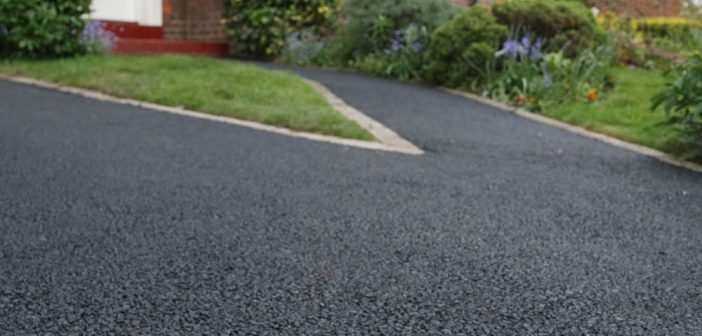When it comes to owning a home, there are always plenty of projects to keep busy with. Since a home is usually one of the most significant financial investments a person makes in their lifetime and is also a person’s primary residence, keeping up with maintenance is critical. This includes properly maintaining the exterior of the home and the driveway. Over time, there are many areas of the exterior of a house that can require preventative maintenance to protect and preserve it, such as the driveway.
During the different seasons, a driveway is subjected to a variety of stresses. Summer is widely known to cause damage to driveways because of excessive heat, hail, and powerful downpours. The good news is that through proper care, homeowners can be assured that it will last them for years to come. When temperatures rise, asphalt can become soft and more readily damaged, and homeowners need to be conscientious of the potential for this.
There is a three-step process that should be done to protect a driveway against the summer heat and potential damage. If this process is followed every several years, then your driveway should last for years to come. Repairs should be completed during the warmth but not during excessive heat to allow for better drying.
Step One: Patch Damaged Areas. For a driveway to be correctly maintained, cracks, ruts and holes in the asphalt should be patched yearly to ensure that the damage does not spread in the summer heat or winter cold season. Cracks are quite common and can spread during the summer heat and the cold of winter. Placing a sealant over any emerging cracks will help ensure they do not expand because of extreme temperatures or heavy precipitation events.
When it comes to ruts and holes, these should be filled in and leveled out to an even smooth surface. Cracks, ruts, and holes can become significantly more damaged with summer storms, summer heat, heavy precipitation and the cold of winter. It is important not to leave damaged areas unpatched for any length of time, or they will expand and worsen especially with excessive rain. Downpours and excessive rain will pour into cracks causing the asphalt to expand. Asphalt patching should be allowed to dry for several days before going on to step two.
Step Two: Sealing and Coating the Driveway. Driveways should be sealed to protect and preserve the asphalt against temperature extremes and other damage. Seal coating provides a protective layer that ensures the asphalt is stronger against weathering. Sealing a driveway can also significantly improve the aesthetics of the driveway, offering a beautiful new charcoal color that enhances the look of a home.
Seal coating will provide driveway protection against heat oxidation and provides a layer of protection against extreme weather events such as hail and damaging rains. When excessive heat and the UV rays of the sun batter asphalt, the oils in the asphalt that hold together the rock elements begin to break down. This causes the surface to become brittle and more susceptible to cracking and crumbling. Seal coating should be done every several years to preserve the driveway after patching has been completed. This is best done during the late spring, early or late summer or during the fall months so that the asphalt seals and dries properly.
Step Three: Ongoing Protection. Homeowners should be conscientious about protecting their driveway against potential damage. Several things can cause damage to a driveway any time of year and should be cautioned against. Sharp objects can cause damage to a driveway, especially when the summer heat is making the asphalt softer. Caution should be used when moving low dragging trailers or cars with low exhaust pipes, lawn care equipment, and outside furnishings. Improperly moving any of these items can cause damage to warm asphalt that has become soft from extreme heat.
Additionally, it is important to be careful not to park heavy vehicles during the heat of the summer on an asphalt driveway which can lead to indentations and damage. When it comes to regular vehicle traffic, the seal coating should be allowed ample time to dry before attempting any parking on the driveway. Once the driveway has properly dried, it can be helpful not to leave a car parked in one spot for long periods during the summer heat. Moving the location of vehicles will help protect against tire indentations from the weight of a vehicle that is left in the same spot for extended periods of time.
Knowing When to Reseal a Driveway
In general, a driveway should be resealed every 3 to 5 years. Watching for the telltale signs of asphalt damage can help determine when it’s time to reseal. Hairline cracks do occur, especially in the winter and summer months. This is usually not a significant concern. However, when the hairline cracks expand or ruts, indentations and small holes start to appear – this is the time to plan the patching and resealing of the driveway again.
Driveways that are left unattended for years at a time will deteriorate from weather extremes of heat and cold as well as heavy precipitation events. Either of these will cause further damage to areas that start as weakened hairline cracks, ruts, and holes. When left unattended, water begins to permeate these areas, and the asphalt expands.
During the winter, asphalt contracts and in the spring, it begins to expand, which causes stress on the composition of the asphalt materials. These weather extremes damage the look and the continuity of asphalt materials. Once asphalt damage is observed, patching and placing a seal coat on is recommended. However, resealing should not be done during the coldest months or the peak of summer since the expansion and contraction cycles are heightened during this period. It is best to have it done during the best drying seasons so that the asphalt coating will properly set.









